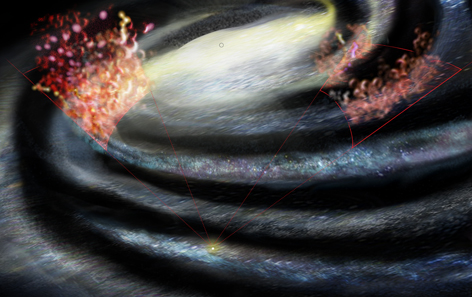A surprising discovery that hydrogen gas clouds found in abundance in and above our Milky Way Galaxy have preferred locations has given astronomers a key clue about the origin of such clouds, which play an important part in galaxy evolution.

Artist's conception shows Milky Way regions studied, with hydrogen clouds
more abundant in region above area where central bar merges with spiral arm.
Bright point at bottom center is location of our Solar System.
CREDIT:Bill Saxton, NRAO/AUI/NSF
We've concluded that these clouds are gas that has been blown away from the Galaxy's plane by supernova explosions and the fierce winds from young stars in areas of intense star formation," said H. Alyson Ford of the University of Michigan, whose Ph.D thesis research from Swinburne University formed the basis for this result. The team, consisting of Ford and collaborators Felix J. Lockman, of the National Radio Astronomy Observatory (NRAO), and Naomi Mclure-Griffiths of CSIRO Astronomy and Space Science, presented their findings to the American Astronomical Society's meeting in Miami, Florida.
The astronomers studied gas clouds in two distinct regions of the Galaxy. The clouds they studied are between 400 and 15,000 light-years outside the disk-like plane of the Galaxy. The disk contains most of the Galaxy's stars and gas, and is surrounded by a "halo" of gas more distant than the clouds the astronomers studied.
See the website for more details. http://www.nrao.edu/pr/2010/haloclouds/ (SY) |
